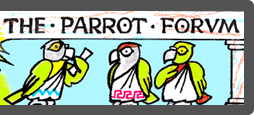entrancedbymyGCC wrote:PRD wrote: Changing their body will result in negative consequentes for the bird.
I understand that you believe that, but can you supply evidence of those negative consequences in a measurable/objective form? How do we observe those negative consequences?
Well, yes and no. I can produce calculations in which i can prove that a wingsurface will carry more load when it's reduced to let's say 75% of it's original(and no other changes to the craft). That the increasement of the mechinical movement of its wing will produce more mechanical stress on its wing can also be proven by figures.
How we observe it is an interestng question which occupies me quite a bit. Because i am not a vet, nor a pilot, i dont have any experience with clipped birds and i only have experience with south american parrots i can only guess. I can say different things.
First of all, there are different types of parrots. Some have better aerodynamics, others have a longer tail, some are large, some are small. I think the effect on all types could be different.
The small parrots need less air cause of their weight to take off, so they would have to be clipped more for instance. I am still working on that part(and everything else)
Looking at my worst flying bird, he is clipped by 1 side. Nobody would even notice the effects it has on the bird. 1 wing is producing more lift then the other. That means making turns 1 way is piece of cake, the other way is a bitch! 1 way he can bank quite alot, the other way he has to be carefull not to bank to much, and will make a wider turn. Producing the same amount of lift with 2 different wingareas requires alot of skills, its like flying a twin engine aircraft on 1 engine. 1 wing will flap more then the other. This will also cause a disbalans, which is undesiarable cause of the mechanical movement of the wings.
Looking from the plane perspective i can say this: Planes dont deal with the mechanical stress as birds, except the helicopter. It needs alot of maintenance and replacement, so i think birds have the advantage that they grow new feathers. I would expect a wing flapper who cant gain altitude and flaps alot to move around to break its fwingseather quiker if they would fall of their perch and would try to fly but instead would hit the cage with their wings and break some feathers. This is an assumption i make. The fact is that higher mechanical stress will result in a higher wearage. I dont know if this would effect the bones, the featherstructure, it's joints or any other part of it's body. If this happens its easy to say he fell and broke his feathers. I have read that on several occasions, also problems with joints. If the bird is on a bad diet, its easy to say thats the bad diet that caused it. Nobody considers the possibility of wearage of the birds structure.
I have also read that up to 80% of bird problems are due to a bad diet. I suspect that in this 80% to be causes that could be a result of not flying, but could look as a bad diet problem. As everybody is focussed on clipping and pellets, nobody considers lack of flying. If some1 cant prove me otherwise i cant exclude these factors. Unless we know the symptoms we cant prove anything. But we can look at planes what could be/is the result, give me 1 reason why it would be otherwise on birds.
I have seen mechanical birds on internet which people build and fly using a small battery. Our birds also make this mechanical movement with their wings. U should try to do the same thing with that 'bird'. Just 'clipping' the wings wouldnt help, u would have to have the correct speed of the wings to go with it. If u succeeded in that, fly it till it breaks. Do the same with a non clipped 'bird', im sure it would last longer.
If u succeeded in that then comes the challenge. Try to 'clip' 1 wing, adjust the proper speed and try to fly it.
I try to keep it as objective as i can. What bothers me a bit are 2 things: all the attention about how to clip a bird, when to cllip a bird, how safe it is etc. I have been to a 1day couse where they didnt mention the flight of parrots once! Not only that, but stating that's dangerous for birds to fly inside a house... How objective is that?
The second: I have spend quite some hours on the internet, looking for evidence to support what i'm thinking. I find it hard to believe it's not written/described somewhere so i will keep looking for more info. I also have bought a book specific about flight of birds, and explaining the differences and similaritys between birds and aircrafts. So i hope in these months to gather enough information to see what consequentes it has on the bird.
I dont know if u know this article, but i think its a good article.
http://www.parrothouse.com/pamelaclark/ ... light.html






